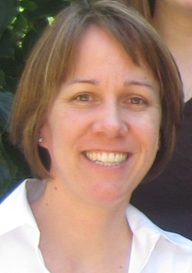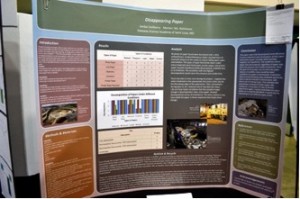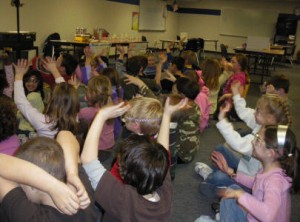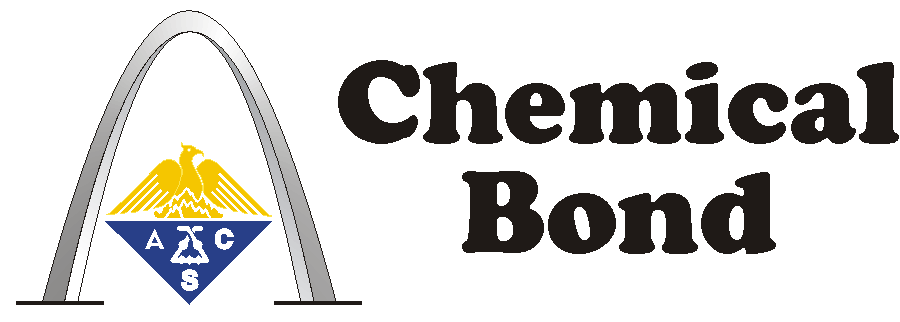
Vol. 66, No. 6, September 2015
In this issue:
- Local Section 2015 Picnic Report
- Sophia Hayes is 2015 Saint Louis Award winner
- Saint Louis Award Banquet 2015
- ACS-STL 2015 Science Fair Chemistry Award Winners
- 2015 Missouri Tri-County Regional Science and Engineering Fair
- National Chemistry Week (NCW) 2015
- Seeking Retirees Eager to Make An Educational Impact
- The Committee on Local Sections (LSAC): Here to Support You
- Saint Louis Chemical Science & Technology Award
- Items of interest from Boston
- Meetings and Seminars
- About the Chemical Bond
Our advertisers:
American Polymer Standards, Inc.
Chemir Analytical Services
micron inc.
Place an ad in the Chemical Bond
Local Section 2015 Picnic Report
Picnic was a wash-out but a good time was held by all who attended
submitted by Jim O’Brien
June 14, 2015, dawned bright and sunny, but true to the weather forecast, did not stay that way. By 11:30 am, sprinkles of rain were growing in abundance but the optimistic organizers still packed cricket, volleyball, Frisbee, horseshoe and other game gear together with food in the hope that the weather would improve and not be as projected. By 12:30 pm, several strong downpours proved the folly of their optimism and rain restricted outdoor activities till the picnic ended at 4 pm (some did stay that long).
Weather notwithstanding, a pleasant time was had by all who attended; some 25 members and their families enjoyed conversing, networking and striking up new acquaintances with old, current, and new faces. The picnic had an Australian theme: shrimp-on-the-barbie with a mango relish. Margaret Allen averted a crisis by going off in the pouring rain to purchase a supply of brats when it was discovered by the organizers that that particular must-have for a BBQ had been left at home.
Photos from the day feature people who attended at various times in the afternoon
Sophia Hayes is 2015 Saint Louis Award winner
Jim O’Brien, Immediate Past Chair of the St Louis Section–ACS and Chair of the St Louis Award Jury, has announced the winner of the 2015 St Louis Award.
Sophia Hayes is Professor of Chemistry Washington University in St. Louis. Her BS is from UC Berkeley in Chemistry, and she spent three years in energy and environmental management consulting at RCG/Hagler, Bailly, Inc. in San Francisco, CA. She earned a PhD in Chemistry from UC Santa Barbara (1999), on a five-year fellowship from Sandia National Lab. At Santa Barbara she worked with Prof. Hellmut Eckert on solid-state NMR of lithium anode materials and amorphous carbons.Dr. Hayes was Directorate Postdoctoral Fellow at Lawrence Livermore National Laboratory (Materials Science) with Dr. Glenn Fox working in collaboration at UC Berkeley (Chemical Engineering) with Prof. Jeff Reimer, constructing an optically-pumped NMR apparatus and studying semiconductors and nanomaterials. She subsequently was named an Alexander von Humboldt Postdoctoral Fellow at University of Dortmund, Germany (Physics) performing optically-detected NMR on semiconductors, in collaboration with Prof. Dieter Suter.
Since 2001, Dr. Hayes has been at Washington University, starting as an Assistant Professor and rising to (Full) Professor in 2015. Her research efforts have been recognized with an NSF CAREER Award (2003), an Alfred P. Sloan Foundation Fellowship (2007), and the Regitze R. Vold Memorial Prize in solid-state NMR (2009).
Dr. Hayes’s research is focused on problems related to materials science where NMR spectroscopy can play a significant role. She and her group build specialized probes (i.e., with light access, high pressure gases, supercritical fluids). Her group is currently focused on three research areas.
- In situ elevated-pressure and -temperature 13C NMR of CO2 for materials discovery in mineralization (forming carbonates) and carbon capture (separating CO2 from flue gases). In this innovative project, in situ high-pressure NMR is employed under conditions that mimic geosequestration environments. This work, as part of a DOE NETL project, is focused on elevated-pressure and elevated-temperature NMR to monitor in situ reactions of CO2 gas with minerals and rocks envisioned for its capture and conversion to stable solid carbonates (such as MgCO3 and CaCO3). Project collaborators include Dan Giammar (Chemical Engineering), Mark Conradi (Physics), and Phil Skemer (Earth & Planetary Sciences). In situ 13C NMR is coupled with a reaction vessel at high pressures to monitor CO2(g) and HCO3—(aq), quantify conversion to CO32— as a solid carbonate, characterize metastable carbonates, and assess pH. In an extension of this work, the Hayes group is assessing flue gas “carbon capture” materials in collaboration with a DOE EFRC team with Chris Jones and Krista Walton (both Chemical Engineering, GA Tech), where NMR can characterize CO2 binding sites, degradative effects of the acidic gases on these materials, and measure temperature-dependent adsorption/desorption reactions.
- Optically-pumped NMR (OPNMR) of semiconductors and semiconductor heterostructures. Dr. Hayes has pioneered research that touches closely on condensed matter physics, the “orienting/ordering” of electrons and nuclear spins through optical pumping. She was the first to combine optically-pumped NMR and optically-detected NMR — two measurement modalities to assess electrons that are polarized in a semiconductor — through laser irradiation with NMR (and optical) detection inside the NMR magnet at cryogenic temperatures. In this research, she has made discoveries in GaAs and recently in CdTe semiconductors, including connecting measurements to the magnetic-field distorted electronic band structure (termed “Landau levels”). Her work has uniquely shown the light-hole transitions very clearly, phenomena not found in other measurement schemes. Her ongoing research has focused on examining the effects of electron localization in semiconductors — a process that affects solar cell performance and other opto-electronic processes.
- Quadrupolar solid-state NMR and modeling of molecular clusters and thin films for “next-generation” semiconductor devices. In a new research focus, Dr. Hayes has undertaken studies of clusters of hydroxo-bridged metals (Ga, In, Al) that are precursors to thin films, similar to indium gallium oxide or “IGO” used in thin film transistor semiconductor devices. She and her group collaborate with Doug Keszler (Oregon State Univ.) and Darren Johnson (Univ. of Oregon) as part of an NSF Center for Chemical Innovation. This work represents some of the earliest studies performed on thin inorganic films (~200-400 nm) of metal oxides, and the Hayes group has discovered and is analyzing unusual NMR lineshapes for 69Ga and 71Ga quadrupolar species. Recent work has extended the thin film analyses to employ an emerging technique, dynamic nuclear polarization (DNP), for surface-sensitive NMR of 27Al in thin films. One of two DNP instruments in the U.S. is in Prof. Marek Pruski’s lab at Ames, and the Hayes group is actively pursuing these new measurements to determine the structure of surfaces of thin films, information critical for their application in devices.
Dr. Hayes is married to Dr. Christopher Hagedorn, a chemical engineer and business executive (and Washington University graduate). They are the proud parents of a daughter, Marina, who has grown up attending NMR conferences, amongst a diverse community of scientists and engineers, who come over to visit and stay with the family for research trips, to play team bocci, and Cranium matches.
Saint Louis Award Banquet 2015
WHEN: Friday, October 16th, directly after the Award Symposium.
6:30 pm cocktails (open bar), 7:00 pm banquet, 8:00 pm program
WHERE: Glen Echo Country Club, 3401 Lucas & Hunt Road, Saint Louis, MO 63121.
Please send reservations, including check, by October 13th to:
Lawrence Barton, Professor Emeritus
Department of Chemistry and Biochemistry
315 Benton Hall (MC 27)
University of Missouri–St Louis
Saint Louis, MO 63121
email lbarton@umsl.edu, or
phone 314.516.5334; cell 314-698-9748; fax 314.516.5342
Make checks payable to Saint Louis Section–ACS, and provide the following information:
Name(s) ________________________________________________________________
Number attending _____ × $60.00 each
amount remitted $____________
Special dietary limitations, if any ___________________________________

ACS-STL 2015 Science Fair Chemistry Award Winners
submitted by Sheryl Loux and Philip Ferko
Co-Coordinators of Science Fair Awards 2015 Greater St. Louis Science Fair
• HONORS GRADES 9-12 DIVISION:
First Place: Joshua Leib Kazdan, “Assessing the Feasibility of Using Photoelectron Imaging to Study Electronic Structure in Cu-,” Grade 11, John Burroughs School, St. Louis, MO. Poster re-titled to ”Copper Catalysts in Carbon Sequetration.”
Second Place: Jordan Sedberry, “Disappearing Paper,” Grade 10, Gateway Science Academy, St. Louis, MO.
Third Place: Rebecca Serrano, “Toxic Metals in Inexpensive Jewelry,” Grade 12, Cor Jesu Academy, Saint Louis, MO.
• GRADES 9-12 DIVISION:
First Place: Maggie Morse and Natalie Rath, “The Effect of Antacids on Difference in pH of Stomach Acid,” Grade 10, Parkway West High School, Ballwin, MO.
Second Place: Samantha Wieprecht, “The Effect of pH on the Corrosion Rate of Iron and Steel” Grade 11, Saint Joseph’s Academy, Saint Louis, MO
Third Place: Susan Albarcha and Yasmine Khan, “The Effect of the Types of Protein on the Temperature at Which They Denature,” Grade 10, Parkway West High School, Ballwin, MO.
• GRADES 6-8 DIVISION:
First Place: Christopher Collver, “Metal-Air fuel cell,” Grade 8, Southwest Middle School, Ballwin, MO.
Second Place: Maryam Noor, “Is there more energy in an almond or a peanut?”, Grade 6, Al- Salam Day School, Ballwin, MO.
Third Place: Alex Meyer “My aren’t u gassy: A study of carbonation,” Grade 7, McKinley Class Leadership Academy, St. Louis,MO.
First Place (Electronically submitted): Dhruv Agarwal, “Don’t Be Nice with the Ice,” Grade 6, Parkway West Middle, Chesterfield, MO.
• GRADES KINDERGARTEN–5TH DIVISION: a congratulatory letter + a purple participation ribbon were each given to 335 chemistry-related entrants this year.
Report of the April 25th, 2015 Missouri Tri-County Regional Science and Engineering Fair
submitted by Sheryl Loux
• GRADES 9-12 DIVISION
There were no place awards given this year.
• GRADES 5-8 DIVISION
First Place: Ashland Higgins and Emily Guan Parham, “Do all chocolate candies have the same melting point?” Grade 5, Claude Brown Elementary, Troy, MO.
Second Place: Austin Uthoff, “What does yeast eat to produce the most carbon dioxide?” Grade 6, Orchard Farm Elementary School, St. Charles, MO.
Third Place: Jake King, “Fruits vs. Vegetables: Which produces more electricity?” Grade 5, Orchard Farm Elementary School, St. Charles,MO.
• GRADES KINDERGARTEN – 4TH DIVISION: a congratulatory letter + a purple participation ribbon were each given to 90 chemistry-related entrants this year.
(note: the Honors Division awards was reported in the April 2015 issue of The Chemical Bond)
American Chemical Society National Chemistry Week (NCW) 2015
submitted by Greg Wall
It is that time again to start thinking about how you can share your passion for chemistry by participating as a volunteer in the premier American Chemical Society public outreach program. The NCW 2015 theme is “Chemistry Colors Our World”, focusing on the chemistry of food colors and fireworks, rainbows, natural dyes and pigments, and more. We will again be partnering with the Saint Louis Science Center to host the event. You may participate as a volunteer, presenter, or sponsor. To join us in the festivities, contact Greg Wall, gwall37@msn.com, to sign up or for further information.
Seeking Retirees Eager to Make An Educational Impact
submitted by Sheryl Loux
Simple equipment and simple setup serves up “States of Matter” to a large group of kids
One of the most popular outreach programs sponsored by the St Louis ACS section is Chemistry is pHun! Sheryl is seeking a retiree to take over this rewarding program or if you would like to offer some of these programs in a school district close to where you live, please contact Sheryl J Loux by email, sjloux@gmail.com or 636.237.5149 to discuss the programs. Training is available.
The twenty-four Chemistry is pHun programs in calendar year 2014 — all given by Sheryl — have had an educational impact on 822 students in 10 or more schools. Program activity for the 2014-2015 school year has started strongly this fall. The program modules offered by Sheryl are “States of Matter, “Chemistry is pHun”, “What is Matter?”, Using the Scientific Method for a Science Fair Project, and “Polymers are Marvelous Molecules” (includes DNA extraction from strawberries). Sheryl thanks Don Sartor and Amy Kerkemeyer for helping with some programs.
Kids having fun and learning; is there a better way to spend a day—for them or for you?
The “States of Matter” program was designed for elementary students and is popular for the 2nd and 3nd grades. The states of matter are explored with solid, liquid, and gas states of mainly water, demonstrating the addition or release of energy in the form of heat when changing physical states. Examples of plasma are mentioned and “Gluep” is made to show a substance that has properties of both liquids and solids.
The “Chemistry is pHun” program is designed for grades 4-12 and covers pH, a review of states of matter, dissolution, chemical reactions, and various polymers.
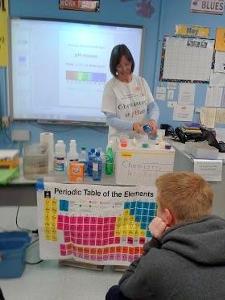
”Chemistry is pHun” for eighth graders demonstrated by Amy Kerkemeyer (shown) and Sheryl Loux (program Coordinator).
Another program for grades K-3 is “What is Matter?” where the periodic table of elements is introduced and water molecules are made with marshmallows for atoms and toothpicks representing electron bonds.
Using the Scientific Method for a Science Fair Project is designed for grades 5-8, and “Polymers are Marvelous Molecules” (includes DNA extraction from strawberries) is for grades7-12.
Of the 822 students participating this calendar year, 610 students have enjoyed the “States of Matter” program, 160 students have enjoyed the “Chemistry is pHun” program, and 52 students extracted DNA in the “Polymers are Marvelous Molecules”.
The Committee on Local Sections (LSAC): Here to Support You
Submitted by Alexa Serfis, St. Louis Local Section Councilor
The ACS Committee on Local Section Activities (LSAC) is composed of 25 ACS Local Section Councilors from Sections of all sizes. LSAC has a number of programs that support Local Sections to help them “Be All They Want to Be”. LSAC has a number of programs Local Sections can take advantage of and LSAC members serve as resources/mentors for Local Sections that need assistance or fresh ideas.
Most of us are familiar with the Annual Report. This report is an on-line report that asks Local Sections to report details of their governance and activities. LSAC members read all reports thoroughly, and provide a review to each Local Section that identifies strengths and suggestions to improve in particular areas. LSAC gathers data from the reports and is compiling Best Practices to be shared with Local Sections. When LSAC notices that a Section appears to be struggling, an LSAC member reaches out to the Section leadership to gather more information and offer mentoring when needed.
LSAC has a grants program to support Local Sections. The Innovative Grants program solicits proposals twice a year from Local Sections. The proposal must describe an activity that is new to the Section, and must describe the impact to the intended audience and the Section in general. A detailed budget and plan for continuing funding after the grant period is also expected in the proposal. Funding is up to $3,000 and Sections can submit one proposal per year. LSAC also has “nano” grants available at different times to provide $100 for themed projects. Recent themes included science cafes and promoting interactions with high school teachers.
ChemLuminary Awards for Outstanding Performance in Local Sections are awarded each year by LSAC at the ChemLuminary Award Event at the fall national meeting. Awards are given in all size categories ranging from small to very large. LSAC counts on Local Sections to self-nominate for this award, and provide details in the Annual Report to support the nomination.
LSAC also sponsors at least two webinars each year, covering topics that are of interest to Local Section members. The webinars are also posted on the “Get Involved” web site, which has extensive information for Local Section leaders and members. To help cultivate new Local Section leaders, LSAC sponsors the Local Section Leaders track at the ACS Leadership Institute in January. The programming is focused on helping new leaders develop successful activities and engage members in their Local Section.
LSAC is a very busy committee, whose members work throughout the year to support Local Sections in carrying out their missions.
Saint Louis Chemical Science & Technology Award – call for nominations
Nominate a member of your team for the Saint Louis Chemical Science & Technology Award. This award is presented to a chemist in the St. Louis area who has demonstrated a high degree of professionalism and scientific contribution. Criteria used to judge the award include technical proficiency, presentations, coaching/teamwork, and additional professional activities. The award will consist of a plaque, a $500 honorarium, and dinner for the awardee and a guest at the annual Recognition Night. The Due date is January 1 2016.
You can find all the details on eligibility, nominating a candidate, and recent winners right here. To submit a nomination, email the Chemical Science and Technology Award Coordinator Pegah Jalili at Pegah.Jalili@sial.com or phone 314.546.9278.
Items of interest from Boston
Our national Councilors have reported from Boston, where the 250th national ACS meeting continues through today. As usual, they have provided the document “Councilor Talking Points” that gives a good summary of governance issues raised, discussed, voted on, etc.
It would be reckless for anyone to try to select the meatiest, weightiest subjects and summarize them for you. You know better what matters to you. So go, give the Talking Points a once-over and learn what has gone on in your name.
Of particular local interest, however, is the following (with thanks to Lisa Balbes for the compilation):
• The St Louis section won two ChemLuminary awards, one for our career programs, and the other for our Senior Chemist event. (There will be futher reportage on these wins in a future post.) We were nominated for three other ChemLuminaries that we did not win: Outstanding Section, Younger Chemists Committee, and high school student activities. With a total of five nominations, we think we have a record for a single year.
• Councilor Donna Friedman was elected to the Committee on Committees. We now have one councilor on each of the three elected council committees. Besides Donna, there’s Lol Barton on the Council Policy Committee and Lisa Balbes on Nominations and Elections. Another outstanding accomplishment!

Board of Directors
St Louis Section–ACS Board of Directors meets the second Thursday of each month, usually at the Glen Echo Country Club (map and driving directions). Meetings are open to all members, and all are encouraged to attend. Elected officers and chairs of major committees vote on questions put to the Board; others in attendance have voice but no vote.
If you want to attend for dinner, please contact the section Chair at least a week in advance. Usual cost of the dinner is $21 ($12 for post-docs and unemployed members). Bar service and dessert are optional extras. Members wishing to become active in section activities are welcomed for their first dinner as guests of the section.
Date: Sept 10
Social hour, cash bar: 5:30 pm
Business meeting: 6:30 pm (suspended for dinner when served)
Future meetings: Oct 8, Nov 12
Saint Louis University
Seminars are on Fridays at 12 noon in Carlo Auditorium, Tegeler Hall, unless noted otherwise. Refreshments follow. For more information, contact Jim Edwards, jedward5@slu.edu. Refer to the SLU Chemistry Department seminar page for the most up-to-date information.
Sept 18
John McLean, Vanderbilt
TBD
Sept 18
Raman Baranidharan, Wash. U.
TBD
University of Missouri–St Louis
Mondays at 4 pm in 451 Benton Hall, unless otherwise specified. Refreshments 15 minutes prior to seminar time. For more information, contact the Chemistry Department, 314.516.5311. Refer to the UMSL Chemistry Department seminar page for the most up-to-date information.
Sept 14
Prof. Parag Banerjee, Washington U, Engineering School
Ternary compound in a binary world: BiOCl nanosheets as efficient photocatalysts
Sept 21
Prof. Joshua Telser, Roosevelt University
A journey across the first row transition metal ions with high field and frequency electron paramagnetic resonance spectroscopy (HFEPR)
Sept 28
Prof. Eric Long, Indiana University, Purdue University Indianapolis
Studies of DNA-Ligand Recognition & Structure: Groove Binders to Bleomycins
Oct 5
Prof. Janet Wilking, UMSL
Luminescent Group 14 Metalloles
Washington University
Seminars are in McMillen 311 at 4 pm unless otherwise noted. For information, contact: Liviu Mirica, mirica@wustl.edu. Refer to the Wash. U. Chemistry Department seminar page for the most up-to-date information.
Sept 3
Mikhail Berezin , Washington University School of Medicine
Imaging of tissue: from Optical Window I to Optical Window II and beyond
Sept 10
Andrew Boydston, University of Washington
New Strategies for Making and Breaking Polymers
Sept 17
Julius Rebek, Scripps
Molecular Behavior in Small Spaces


The Chemical Bond is published at www.stlacs.org January through May and September through December by the St Louis Section–American Chemical Society. If you would like to receive email notification when each issue is posted, you can subscribe to our email list and join the “Chemical Bond reminders” group.
|
Correspondence, letters to the editor, etc., should be emailed to editor@stlacs.org Copyright © 2015 American Chemical Society and the St Louis Section–ACS |
||
| Editor | Eric Ressner | 314.962.6415 editor@stlacs.org |
| Associate Editor | Margaret Allen | editor@stlacs.org |
| Assistant Editor & Advertising Manager |
Keith Stine | 314.516.5346 advmgr@stlacs.org |
| Business Manager | Donna Friedman | 314.513.4388 bizmgr@stlacs.org |




